What are pivot doors?
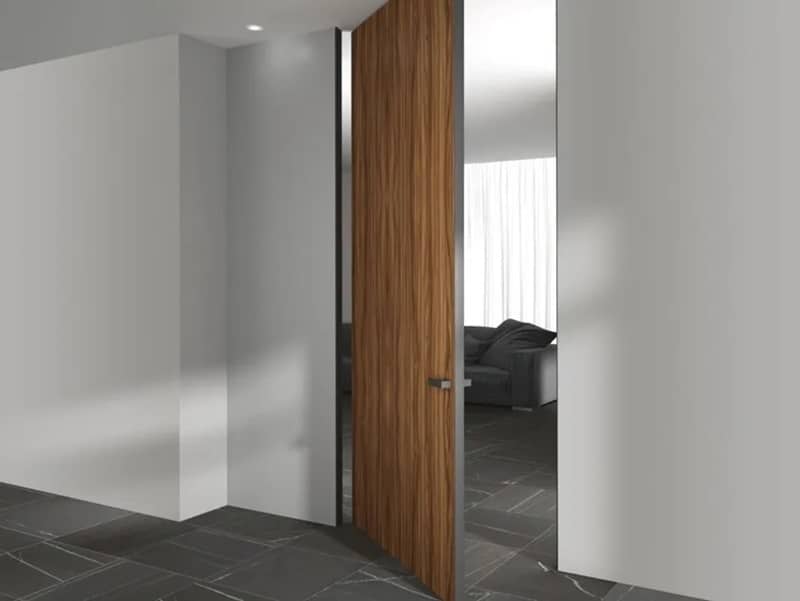
Pivot doors are a type of entry door system that operates on a unique mechanism, differing from traditional hinged doors. Instead of being attached to a door frame with hinges on one side, pivot doors are mounted on pivots or pins at the top and bottom of the door. These pivots allow the door to rotate around a central, vertical axis, typically offset from the door’s center, either closer to the edge of the middle.
Pivot doors are often used for their aesthetic appeal and modern design, as they can create a statement in residential and commercial settings. They are available in various materials, including wood, glass, metal, and composite, and can be customized to suit different architectural styles.
Some benefits of pivot doors include the following:
- Larger door sizes: Pivot doors can be designed larger than traditional hinged doors, making them ideal for oversized entryways and creating a grand entrance.
- Smooth operation: The pivot mechanism allows for a smooth and easy process, even with more oversized, heavier doors.
- Minimalistic design: Pivot doors often feature a clean, minimalistic design, which can add a contemporary touch to a space.
- Unobstructed views: When open, pivot doors can provide free pictures and seamless indoor-outdoor transitions, especially with glass or other transparent materials.
However, pivot doors may also have some drawbacks, such as:
- Cost: Pivot doors can be more expensive than hinged doors due to their specialized hardware and custom design requirements.
- Insulation and sealing: Ensuring proper insulation and sealing around the pivot door can be challenging, which may result in drafts or reduced energy efficiency.
- Space requirements: Pivot doors need ample space to swing open and close, which may not be suitable for all locations.
How do pivot doors work?
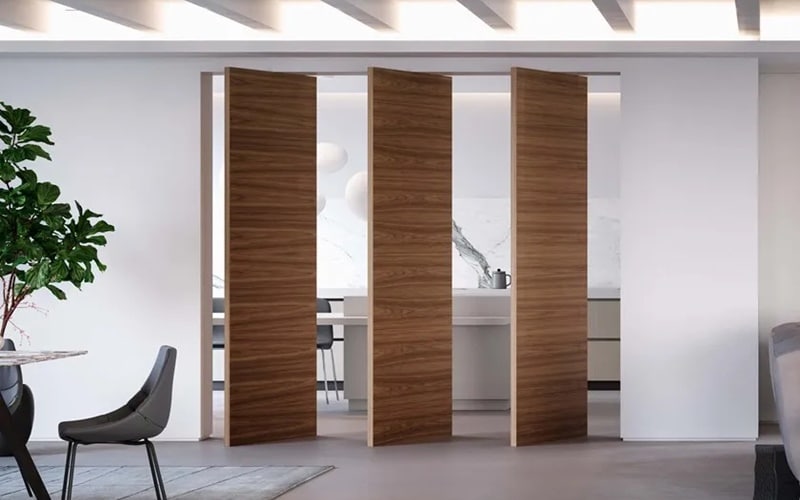
Pivot doors work on a unique mechanism that relies on pivot points or pins rather than traditional hinges. These pivot points are located at the top and bottom of the door, allowing it to rotate around a vertical axis. The axis is typically offset from the door’s center, either closer to one edge or the middle.
Here’s a breakdown of how pivot doors work:
- Pivot points: The top and bottom pivot points are securely anchored to the door frame and the floor (or threshold), respectively. These pivots act as the fulcrum for the door’s rotation.
- Door rotation: When the door is opened or closed, it rotates around the vertical axis created by the alignment of the top and bottom pivot points. The door’s weight is distributed evenly between the two pivot points, which allows for smooth and easy operation, even with larger and heavier doors.
- Offset axis: The position of the pivot points determines the door’s swing and appearance when opened. If the pivot points are positioned closer to one edge, the door will have a wider swing arc and reveal a larger opening when fully extended. If the pivot points are closer to the center, the door will have a narrower swing arc and open more balanced, with part of the door extending into the room and outside.
- A doorstop is typically installed to prevent the pivot door from over-rotating or swinging too far in either direction. This can help protect the door, the pivots, and the surrounding structure from potential damage.
- Sealing and insulation: Pivot doors often have specialized weatherstripping and seals to ensure proper insulation and to prevent drafts when the door is closed. These seals may be installed around the door’s perimeter or integrated into the door’s design.
The unique operation of pivot doors makes them an attractive option for contemporary designs and grand entrances, as they offer a distinct aesthetic and functionality compared to traditional hinged doors. However, they may require more space for their swing arc and can be more expensive to install and maintain due to their specialized hardware and custom design requirements.
Pivot door disadvantages
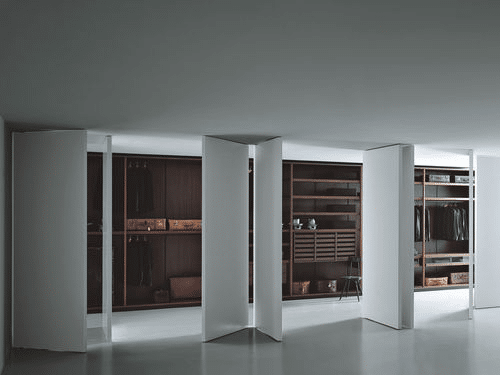
While pivot doors can be an attractive and unique addition to a building, they also have disadvantages. Some of the drawbacks include the following:
- Cost: Pivot doors can be more expensive than hinged doors due to their specialized hardware, custom design, and installation requirements. The cost of the door itself, as well as labor and materials for installation, can be higher compared to standard doors.
- Insulation and sealing: Ensuring proper insulation and sealing around a pivot door can be challenging. Gaps around the door’s perimeter may lead to drafts, reduced energy efficiency, and potential water ingress during heavy rain or storms. This may require additional measures, such as weatherstripping or custom seals, to maintain an energy-efficient, weather-tight seal.
- Space requirements: Pivot doors need ample space to swing open and close, which may not be suitable for all locations. They may not be the best choice for small or narrow entryways, as their swing arc could interfere with furniture or other objects in the surrounding area.
- Privacy and security: Due to their unique design and potential gaps around the perimeter, pivot doors may offer slightly less privacy and security than traditional hinged doors. Additional locking mechanisms or reinforced materials may be necessary to address this issue.
- Maintenance: The pivot hardware may require frequent maintenance and adjustments to ensure smooth operation, especially if the door is exposed to heavy use or harsh environmental conditions. This can include lubricating the pivot points and providing the door is properly aligned and balanced.
- Limited styles and options: While pivot doors are available in various materials and designs, they may not be as versatile as traditional hinged doors for matching a specific architectural style or aesthetic. Some people may find the options for pivot doors to be more limited in design, material, and finish.
Despite these disadvantages, pivot doors can still be a stunning and functional choice for specific applications, particularly in modern or contemporary settings where their unique appearance and operation can make a strong visual impact.
Pivot doors prices
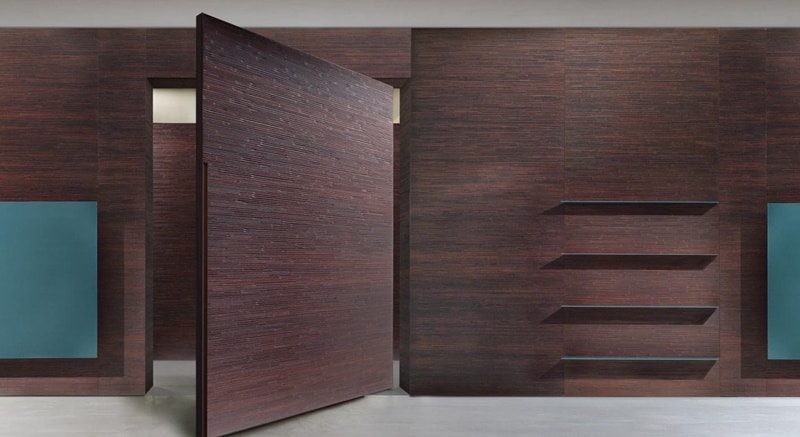
The prices of pivot doors can vary greatly depending on materials, size, design, hardware, and level of customization. It’s essential to remember that the costs mentioned here are approximate and may not accurately reflect current market prices or specific project requirements. As of my last knowledge update in September 2021, typical price ranges for pivot doors are as follows:
- Basic pivot doors: For a basic pivot door made of materials like MDF or simple wood, prices can start around $1,000 and go up to $3,000. These doors may have a simple design and less intricate hardware.
- Mid-range pivot doors: For mid-range doors made from solid wood, metal, or glass, prices range from $3,000 to $7,000. These doors typically have better hardware and may offer some level of customization.
- High-end pivot doors: Custom, high-end pivot doors made of premium materials like exotic woods, high-quality metals, or specialty glass can cost anywhere from $7,000 to $20,000 or more. These doors often feature intricate designs, top-quality hardware, and superior craftsmanship.
Additional costs to consider include:
- Hardware: High-quality pivot hinges and other hardware components can cost anywhere from $100 to over $1,000, depending on the material, finish, and weight capacity.
- Installation: Professional pivot door installation can range from a few hundred dollars to over $1,000, depending on the project’s complexity and local labor rates.
- Finishing and accessories: Custom finishes, specialty glass, or additional accessories like door handles, locks, and weatherstripping can add to the overall cost of a pivot door.
- Shipping: If you’re ordering a pivot door from a remote location or overseas, shipping costs can significantly add to the overall cost of the door.
Getting multiple quotes from suppliers and contractors is essential to find the best price for your needs and budget. Investing in a high-quality pivot door with proper installation can provide better long-term value in durability, performance, and aesthetics.
What is the difference between hinge and pivot shower doors?
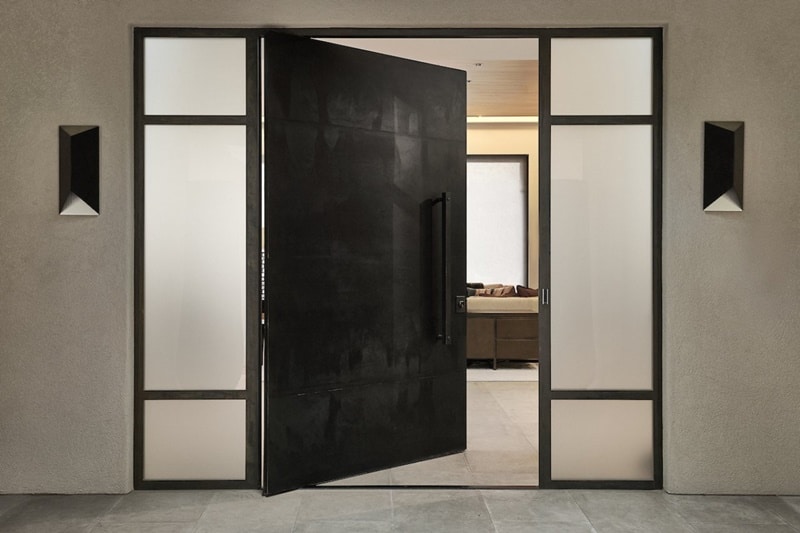
Hinge and pivot shower doors are two shower enclosures that differ primarily in how they open and close. Here’s a breakdown of the critical differences between hinge and pivot shower doors:
- Hinge shower doors:
- Hinge shower doors are designed with hinges that attach the entrance to the shower frame or a stationary glass panel.
- They typically open outward in a swinging motion, similar to traditional doors.
- Hinge doors usually require more clearance space outside the shower to accommodate the door’s swing arc.
- They are available in single or double-door configurations, with the double-door design offering a wider opening.
- Hinge shower doors tend to be sleek, with minimal hardware visible when the door is closed.
- Pivot shower doors:
- Pivot shower doors use a set of pivot points or pins located at the top and bottom of the entry (or sometimes only at the top) to allow the door to rotate open and closed.
- They usually open inward, outward, or both depending on the specific design.
- Pivot doors require less clearance space outside the shower than hinge doors, as their swing arc is narrower.
- They typically come in single-door configurations but can be paired with stationary glass panels to create wider openings.
- Pivot shower doors often have a more robust and slightly more visible hardware system than hinge doors.
Both hinge and pivot shower doors have their advantages and drawbacks. Hinge shower doors offer a wider opening and a sleeker appearance, but they require more clearance space outside the shower. Pivot shower doors need less clearance space and can open in multiple directions, but they usually have a narrower opening and more visible hardware.
When choosing between hinge and pivot shower doors, consider factors such as the size and layout of your bathroom, your preferred aesthetic, and your specific needs regarding accessibility and functionality.
Which type of door lock is best for pivot doors?
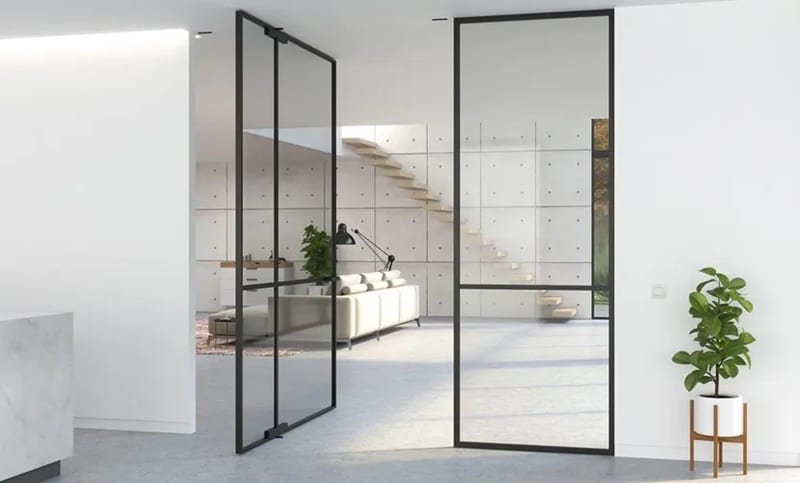
Selecting the best type of door lock for a pivot door depends on your specific security, aesthetic, and functional requirements. However, some commonly used and effective door lock options for pivot doors include:
- Mortise locks are famous for pivoting doors for their strength, security, and versatility. They are installed within a cavity (or mortise) inside the door, making them less visible and providing a clean appearance. Mortise locks are available in various designs, including deadbolt, latch, and multi-point locking systems, which can enhance the security of your pivot door.
- Electronic locks: Electronic locks can provide additional security and convenience for pivot doors. These locks can be operated using a keypad, fingerprint scanner, or a smart device, eliminating the need for a physical key. Some electronic locks also offer remote access and monitoring features, allowing you to control and monitor the safety anywhere with an internet connection.
- Magnetic locks: Magnetic locks use an electromagnet to secure the door when closed. These locks are often used in conjunction with other locking systems, as they typically do not provide the same level of security as mechanical locks. However, they can offer a sleek and minimal appearance, as the locking mechanism is concealed within the door frame or the pivot door itself.
- Euro cylinder locks: Euro cylinder locks are another option for pivot doors, as they can provide a high level of security and are available in various sizes and configurations. These locks use a cylinder and critical mechanism and can be easily replaced or upgraded without changing the lock.
- Flush bolts: Flush bolts can be used as secondary locking mechanisms for pivot doors, especially for double pivot doors. They are installed within the edge of the door and slide into a socket on the floor or header to secure the door. Flush bolts can be operated manually or automatically and are usually concealed when the door is closed, providing a clean appearance.
When choosing the best door lock for your pivot door, consider factors such as security, aesthetics, ease of use, and integration with your existing security system. It’s essential to consult with a professional locksmith or door installer to ensure that your chosen lock is compatible with your pivot door and provides the desired level of security and functionality.

